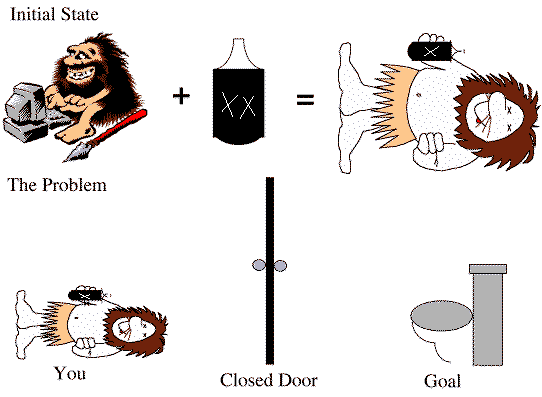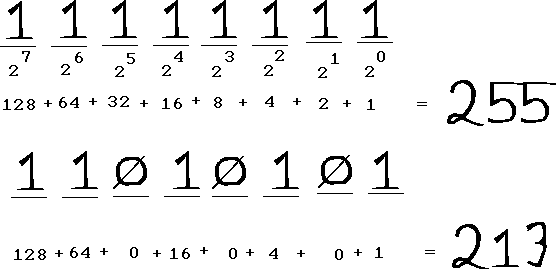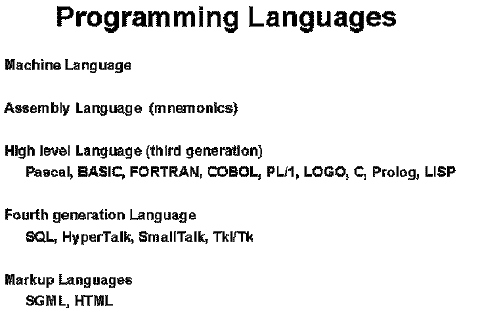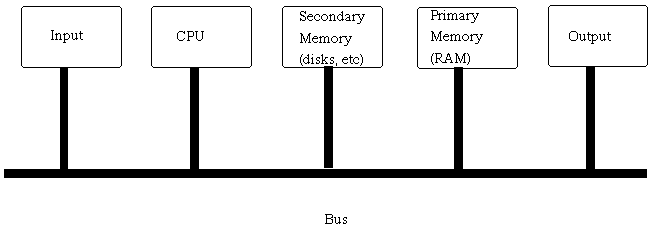CPS 125
Alexander Ferworn
Week 1
Main Topics
Note: In this document everywhere you see
a -- it means double quotation mark.
- Problem solving - programming
- Algorithms
- Running a program
- Compile, link and go
- programming languages
- Computer Architecture
Why Bother?
Motivation: Computers and programming are important because they let
people do what they like to do best--NOTHING!
Example: 1981 U of T Chemistry lab, taking reading for 4 hours in 15 second
increments...bet a computer would have helped.
Example: Get off of unwanted mailing lists. Auto-reply mail message written
in a programming language called PERL.
To: <Goof who sent me junk mail>
From: aferworn@on.bell.ca
Subject: In reply to your offer of making me rich by purchasing <Stupid
product name>
Greetings and Salutations,
Thank you for your generous offer of making me rich by the simple purchase
of <Stupid product name>.
Unfortunately I must pass this time. But, I was so pleased about
being on your mailing list that I am sending you a 25 Megabyte Quicktime movie
titled --The best of PeeWee Herman--. Thank you for your attention,
Alex Ferworn
Problems: problems are challenges you experience in your life.
Example:

Problem: You wake up and you are hung over and would really, really like to
visit your bathroom down the hall. What do you do?
Potential Solutions:
- Spew in place and go back to sleep
- Make creative use of the new IKEA chest of drawers
- Think of a way to get to the toilet on time.
Algorithms: An algorithm is a step-by-step set of instructions for
executing a particular task for communication to a human.
Algorithms have the following characteristics
- Algorithms are precise. Each step is explicit
- Algorithms are effective. The task is always done as required
- Algorithms have a finite number of steps
- Algorithms must terminate
Here is a toilet algorithm
1) Open your eyes
2) Stand up
3) Walk to the door
4) Open the door
5) Walk to the toilet
6) Spew your guts out
7) Stop
Computers and Programs: A program is an algorithm described to a computer.
A computer is a device which is capable of executing a program.
Computers have the following characteristics of interest
- They are exceedingly fast
- They are monumentally stupid
Binary and Machine Codes
- They Only understand binary (1Ãs and 0Ãs)
- Everything must be told to them exactly
Of course, binary digits (bits) can only be on or off, so some clever guy
thought it might be fun to group more than 1 bit with another. Now you can
encode more than two thing in this way (Why is that you can only encode 2
things with 1 bit?).
Suppose you had two bits grouped together. You could represent 4 things. For
example we could encode how well you are doing in this course.
Example
00 = Excellent work
01 = Good work
10 = Poor woork
11 = Considering MacdonaldÃs University
So, we could encode everything as grouped 1Ãs and 0Ãs.
The standard is to group 8 bits into something called a byte. 8 bits give
you the possibility to represent 256 things (0 to 255).
To confuse things a bit more, each byte can represent either a number (data)
or an instruction. Forget this for the moment and we will assume each byte is a
number representing an instruction.

Language Interpretation
These byte codes are called Machine Codes or Machine Language.
Computers like them because they can be executed directly by the machine. It
just reads a code, interprets
what it means and does that action.
If you make the bytes represent words you can tell a computer about your
algorithm. So, here is an example dictionary of bytes/words (this is not a real
machine language just an Alex example).
Example
00000000 = OPEN
00000001 = EYES
00000010 = STAND
00000011 = WALK
00000100 = OPEN
00000101 = DOOR
00000110 = TOILET
00000111 = SPEW
00001000 = STOP
We could tell the computer our algorithm
00000000 00000001
00000010
00000011 00000101
00000100 00000101
00000011 00000110
00000111
00001000
Assembly Language
Well this is all well and good but there must be an easier way...who can
remember all those codes. So the bright guys got to work and they created
something called assembly language
which shortened all the commands into assembly codes and grouped some of the
related stuff together.
OPEN(EYES)
STAND
WALK(DOOR)
OPEN(DOOR)
WALK(TOILET)
SPEW
STOP
Translation and Interpretation
Computers can almost execute this stuff directly (interpret it) since only a
simple translation is required from the
mnemonic (English-like command).
High-Level languages
This was fine but it soon became clear that if there was a complex problem
the program would be horrendous to write. ThatÃs where higher level
languages come in.
Higher level languages hide some of the obscurity of the machine. In Machine
Code and Assembly Language the programmer must specify everything. This is a
problem because many times the same code is written again and again which could
lead to errors as things are mistyped.
Higher level languages (like C) avoid this problem by making each command
group together a whole bunch of lower-level machine code--you donÃt
have to keep repeating these codes yourself--possibly introducing more errors
(since you never learned how to type).
#define EYES 0
#define DOOR 1
#define TOILET 1
#include <stdio.h>
void main()
{
open(EYES);
stand();
open(DOOR);
walk(TOILET);
printf(SPEW);
}
There are of course even higher level languages--the higher you go, the more
stuff is done for you. The repetitious stuff now happens in the background.

Compilation, linking and executing
Computers cannot interpret high level languages directly because the codes
are more complex and rely on functions which may be hidden someplace either in
the depths of the language or in a library of common routines. The computer
must now go through several steps;
- It must translate the high-level language program into machine code routines, so that it can understand it. This is call compiling the program. Each one of those high level language commands is replaced with the lower level code it represents. This is great because the compiler will not allow you to enter a program which is syntactically incorrect. A syntax error is one in which you break the language rules and is the only type of error picked up by a compiler
- It must get the code resources that the program needs from libraries of common functions. These functions are not actually part of the high-level language but may be written in it. For example, in C there is no command to sort a list of numbers but you could write a program to do it. If you wanted to reuse this program you could store it in a library from which other programs could use it. This is called linking or link editing. You need to link because the language is only so big and you might need to call sub-programs which are stored in libraries of commonly used code which you link to. Linking allows you detect error like--the darn thing isnÃt in the library. This is a linking error.
- Finally the computer is able to execute the translated and linked program--called execution or go! Note: at this stage the machine code is being executed--not the high level language. An error at this point is called an execution error and normally has something to do with the logic of your program--meaning that although what you have written makes sense syntactically and links fine you still cannot solve the problem because what you are saying in the program makes no sense semantically. An error may also mean there is some sort of physical problem. For example if your program is designed to print something on a printer and you run it without an actual printer attached to the computer you will receive an execution or run time error.
A Computer Architecture
Introduction
There are only three things you need to worry about when baby sitting
kids...
- Can you communicate with them?
- Can they remember what you said?
- What are they going to do about it?
They do this with their;
- Ears, eyes, nose, mouth, gestures, etc
- memory
- brain
Computers are like small children because there are essentially only three
things to worry about.
- Input/Output
- Memory
- Processing Units
Input/Output peripherals
These are the things that allow you to tell the computer things and let it
tell you things. Sometimes a device
(physical piece of hardware) will perform both functions at different times
(disk drive).
- Keyboards,
- mice,
- track balls,
- Tape drives,
- CD ROMS,
- printers
Memory
Computer memories are capable of storing bits over time. The memory of a
computer is not a single entity (although in many cases you can think of it
that way). It is a collection of units dispersed in space and function with a
spectrum of speeds, capacities and costs.
You may have seen this yourself,
- Video RAM = $$$$$
- Memory = $$$
- Disks = $
Memory can only store bits because the tiny circuitry that makes up each
spot in memory only knows how to be on or off (1 or 0).
Primary memory refers to memory that
is typically on-board the circuit board that is your CPU board. Secondary
memory is everything else.
If you forget all that, you can think of memory as a long narrow sheet of
paper. You can only write one thing on each line of the paper and then you must
go to the next line. The same is true for reading it. So , to get from any one
line to any other you just need to add or subtract an integer value from where
you are to where you want to go....you can jump around in memory.
Processing Unit
The Central Processing Unit (CPU) is
responsible for executing the programs that you write and that are resident in
your computer already (like the operating system which is also a program that
runs your program). To do this it needs a number of things
Program Counter (PC): A location in
memory that contains the location of the next instruction to execute. Because
the chunk of memory is accessed so often, you want it to be done quickly so the
PC is in an area of faster memory. Things in this space are called registers.
Instruction Register (IR): Got to
put the instruction some place so it can be interpreted...this is where it
goes.
To do any complex math, like adding one to something, the CPU uses a special
math processor called the arithmetic/logic unit (ALU). This device is capable of doing math.
What the CPU does:
- Get the contents of memory pointed to by the PC and put it in the IR
- Increment the PC
- Figure out what the instruction means and get anything else needed (operands)
- Execute the command (with the help of the ALU, other register and memory)
- Go back to 1.
Hooking the whole thing up

All these devices share data across a bunch of wires called a bus. The width of a bus is the amount of bits that it
can carry in parallel at once. So, a 16 bit bus can carry 16 bits at once.
The C Language
C was created by Dennis M. Ritchie, in 1971 as the successor to the language
`B'. The first dialect of C is now called `common C' or `classic C' and differs
slightly from the new ANSI (American National Standards Institute) C standard
which was adopted in 1983. C is a very fast and efficient yet flexible language
often used for programs where speed and developer control are vital. In 1973, the UNIX OS was written almost
entirely in C and the language remains closely linked to this OS. The
flexibility of C comes with a price since it does not enforce good style and
type checking the way that other high level languages like Pascal, BASIC of
Java. This means that C is more
error prone and more difficult to `debug'. Despite these drawbacks, C was the
most widely used programming language during the past three decades and is only
now losing favour to object oriented languages such as C++ and Java.
C forms the basis of its object oriented successor C++ which was created in
1991 Bjarne Stroustrup. Since C++ is very nearly a superset of C.